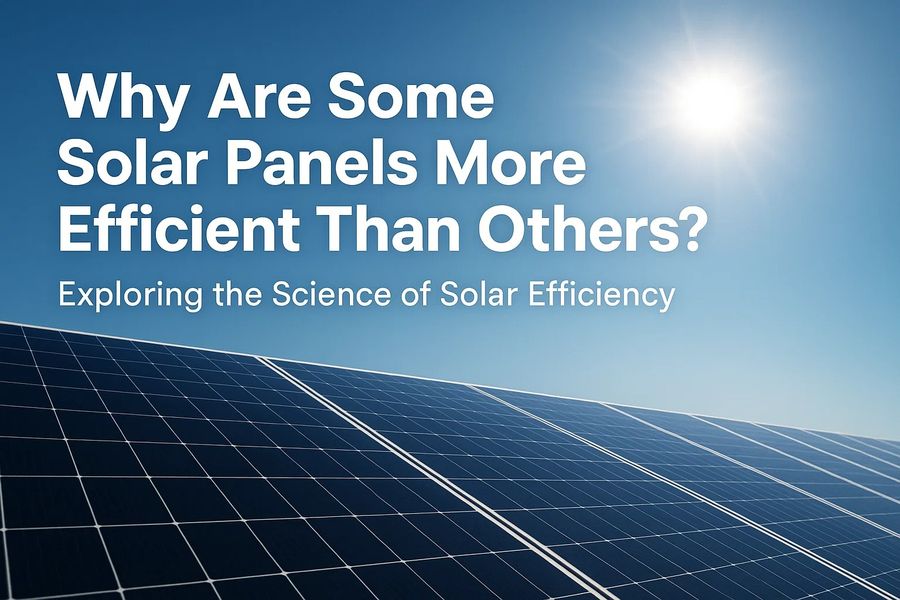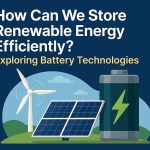Solar panels are becoming an increasingly common sight — on rooftops, in fields, and even on satellites. But if you’ve ever shopped for solar equipment or read product labels, you’ve likely noticed a key metric: efficiency.
Some solar panels advertise 20% efficiency, while others boast 24% or higher. That difference may sound small, but over time, it can significantly affect how much energy your system produces and how much space you need.
So, why are some solar panels more efficient than others? What goes into making a panel better at converting sunlight into usable electricity? Let’s explore the science, technology, and materials behind this fascinating subject. 🌞🔋📈
📈 What Does Solar Panel Efficiency Mean?
Solar panel efficiency is a measure of how much sunlight (solar energy) hitting the panel is converted into usable electrical energy.
For example:
-
A panel with 20% efficiency converts 20% of the sunlight it receives into electricity.
-
If 1000 watts of sunlight hits a 1m² panel, and it produces 200 watts of electricity, it has 20% efficiency.
Higher efficiency means more power from the same surface area — which is especially valuable when space is limited.
🔬 How Do Solar Panels Work?
All solar panels use photovoltaic (PV) cells, which convert sunlight into electricity using the photovoltaic effect.
Basic Steps:
-
Sunlight hits the PV cell, exciting electrons in a semiconductor material (usually silicon).
-
Excited electrons move, generating an electric current.
-
Wiring collects the current, sending it to an inverter and into your home or battery.
So, the efficiency of a panel depends on how well its materials and design allow for this energy conversion process.
⚙️ Factors That Affect Solar Panel Efficiency
1️⃣ Material Type: The Heart of the Cell
Different materials absorb and convert light more effectively.
🟦 Monocrystalline Silicon
-
Made from a single, pure silicon crystal
-
Higher efficiency: 20–24%
-
Dark black appearance, rounded edges
-
Most efficient commercially available panels
🟥 Polycrystalline Silicon
-
Made from multiple silicon fragments melted together
-
Lower efficiency: 15–18%
-
Bluish appearance
-
More affordable, but less efficient
🟨 Thin-Film (Amorphous Silicon, CIGS)
-
Layers of materials like cadmium telluride or copper indium gallium selenide
-
Lower efficiency: 10–13%
-
Lightweight, flexible, great for portable use
-
Best for special applications, not rooftops
2️⃣ Cell Design and Engineering
-
PERC (Passivated Emitter Rear Cell) technology adds a reflective layer to bounce unused light back into the cell.
-
Multi-junction cells layer different materials to capture multiple light wavelengths, achieving up to 40–47% efficiency in lab settings (used in satellites, not homes).
-
Half-cut cells reduce resistance and improve shade tolerance.
3️⃣ Anti-Reflective Coatings
Light that bounces off the surface doesn’t get converted into electricity. Modern panels use:
-
Textured glass to trap more light
-
Anti-reflective coatings to absorb more sunlight
4️⃣ Temperature Coefficient
Solar panels get hot — but heat can reduce efficiency!
-
A lower temperature coefficient means better performance in hot climates.
-
Monocrystalline panels usually perform better in high heat than polycrystalline ones.
5️⃣ Wiring and Connections
Better wiring = less resistance = higher efficiency.
-
Busbars conduct electricity across cells. More busbars (like in 9BB panels) reduce resistance.
-
Shingled cell designs overlap cells to reduce gaps and enhance energy capture.
🏗️ Real-World vs. Laboratory Efficiency
| Setting | Typical Efficiency (%) | Notes |
|---|---|---|
| Lab (Research) | 40–47% (multi-junction) | Extremely efficient but expensive; not for homes |
| High-End Commercial | 22–24% | Monocrystalline, PERC, or bifacial designs |
| Standard Commercial | 15–20% | Most rooftop solar panels |
| Thin-Film | 10–13% | Lightweight and flexible applications |
🌞 What Else Impacts Solar Efficiency?
Beyond panel technology, these external factors affect performance:
🧭 Angle and Orientation
-
Panels should face the sun directly (south-facing in the northern hemisphere).
-
The tilt angle matters for maximum year-round exposure.
☁️ Shading
-
Even small shadows can drastically reduce output.
-
Modern panels with microinverters or power optimizers help reduce this loss.
🧼 Dirt and Maintenance
-
Dust, bird droppings, and grime block sunlight.
-
Regular cleaning improves energy output.
🔥 Temperature
-
Solar panels work better in cooler environments.
-
High temperatures reduce voltage output.
💡 Why Choose High-Efficiency Panels?
| Scenario | Benefit of High-Efficiency Panels |
|---|---|
| Limited Roof Space | Maximize energy output in a small area |
| Long-Term Investment | Higher lifetime energy yield |
| Off-Grid Systems | Better performance under suboptimal sunlight |
| High Energy Demand Homes | Meet electricity needs with fewer panels |
While high-efficiency panels cost more upfront, they often save more in the long run through increased production and reduced need for additional equipment.
🔮 The Future of Solar Panel Efficiency
New materials and designs are pushing boundaries:
🧪 Perovskite Solar Cells
-
Cheaper, lighter, flexible — with lab efficiencies approaching 30%
-
Still being tested for durability
🪞 Bifacial Solar Panels
-
Capture sunlight from both front and rear (using ground reflection)
-
Boosts efficiency by 10–15%
🌈 Tandem Cells
-
Combine different technologies (e.g., silicon + perovskite)
-
Designed to absorb a broader range of the light spectrum
With these innovations, we may soon see 30%+ efficient commercial panels, changing how we build solar farms, EV chargers, and home systems.
🧾 Conclusion: The Power of Smart Solar Choices
Not all solar panels are created equal — and their efficiency depends on material, design, and engineering. Whether you’re installing panels on your home, evaluating technology for a business, or just curious about clean energy, understanding solar efficiency helps you make smarter, more sustainable decisions. 🌍🔋
As solar science advances, we’re moving toward a future where clean, abundant, and highly efficient energy is not just possible — it’s the new standard. ☀️🏡🌱


